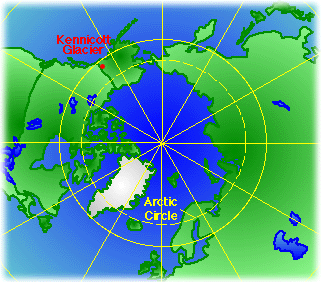
|


In my spare time, I spend time with my wife Michele and two young children.
As a family we enjoy outdoor activities - skiing during the winter and
hiking in the summer, as well as accessing childrens museums and
performances in the Portland area.
The Kennicott Glacier is a valley glacier which originates in the Wrangle-St. Elias Range of south-central Alaska. The glacier flows for many miles down the Kennicott Valley and terminates near a small town called McCarthy. As with all glaciers in the temperate zones of the earth, meltwater from throughout the Kennicott glacier discharges at its terminus. Every spring when snow is rapidly melting from adjacent mountains, lakes fill tributary valleys of the glacier-laden Kennicott valley. These lakes occur because water from these lower elevation tributary streams backs-up behind the ice barrier created by the imposing presence of the Kennicott Glacier at their confluence. The largest of these ice-dammed lakes is called Hidden Creek Lake, located approximately 10 miles up-valley from the terminus at McCarthy. After accumulating water during the spring, Hidden Creek Lake drains its water beneath the glacier ice dam into the base of Kennicott Glacier. This occurs every summer in late July. At the same time, the stream which discharges at the snout of the glacier increases its flow by a factor of 8. This glacial outburst of water poses hazardous flooding conditions for the residents and visitors of McCarthy, Alaska. It also presents an opportunity to learn more about the dynamics of glacial outburst floods. Unlike the regularity of the Hidden Creek Lake release, most other glacial outburst floods unexpectedly present their hazard in other areas of North America, Europe, central Asia, and regions where temperate valley glaciers occur. One of the hypotheses is that as the lake accumulates water, it "floats" the ice dam so that the water can escape beneath and around the glacier. A second, and more complicated hypothesis includes the floatation model, but also suggests that leakage occurs slowly into an existing network of relatively small channels beneath the glacier, and as the summertime air temperatures increase glacial meltwater, larger subsurface channels develop their way up the mainstem of the glacier which the "leaking lake" eventually accesses. When this hydraulic connection occurs, the lake is hypothesized to drain catastrophically.
There will be three major aspects to the study. Using laser-directed
surveying equipment, one team of researchers will be carefully measuring
the change in elevation of the ice dam as it is floated by the rising
waters of Hidden Creek Lake. Another part of the study will carefully
monitor the water and sediment output from the stream at the glacier
terminus. The third aspect of the study will use steam drills to bore
through the ice in the glacier, after which the water passing beneath the
glacier will be carefully monitored by pressure sensing devices and
micro-video cameras. The study coordinates a multifaceted capture of data
during a known outburst flood using principles of geology, glaciology,
hydrology, and physics. It should be fun!
 July 2000
June 2000
July 1999
|



